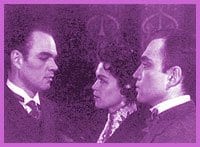Remember the Crest Theatre? You’re entitled to draw a blank – or flash an image of toothbrush puppets. If you’re 50-plus and grew up in Toronto, you just might recall an oasis of verve and panache in a sleepy enclave of North Toronto. At 551 Mt Pleasant Rd in 1954, Canada’s first homegrown “legitimate” (read commercial) theatre opened its doors, thanks to the vision of two gay brothers, Donald and Murray Davis, and their sister Barbara Chilcott.
The Crest movie theatre, just south of Eglinton, was a moribund vaudeville house before it began packing in film crowds. When movie fans decamped to the novelty of TV, the Davis siblings, still in their 20s and with professional stage experience in England and the US behind them, foresaw a gaping hole in their hometown arts scene.
Donald and Murray had already enjoyed success with their Ontario summer stock theatre company, the Straw Hat Players. Heading home from cottage country in September of 1953, they were itching for a new challenge. They went for the big one: establishing a professional repertory company in a town where live theatre was either imported or dismissed as amateur.
Toronto writer Paul Illidge opens with a sampling of the philistine horrors of 1953 Toronto. Artistic ambition struggled under a pall of homegrown humiliation. “Celia Franca’s National Ballet Company used the upper level of the St Lawrence Market for its rehearsals… under pigeon-crowded roof beams.” Toronto Symphony patrons could not abide Stravinsky or Sibelius, and theatre mavens were a conservative bunch still in thrall to the US and Brit touring productions that kept King St’s Royal Alexandra Theatre the only “legit” house in town.
Murray and Donald, with their sister’s blessing and her chunk of the family inheritance, wrangled a lease from Famous Players and moved into the Crest that November, with plans to raise the curtain on a first production in January. Stage, lobby, lighting and seating had to be upgraded and reconfigured, and a show cobbled together in time for a Jan 5 opening. Upping the ante, the Davis brothers scheduled a medieval costume drama with a cast of 16. They pulled it off. Directed by their friend John Blatchley, “a rising star” in British theatre, the show was a hit. Two weeks later the Crest mounted The Philadelphia Story with a cast of 13. Two weeks after that, a new design and a dozen new costumes were required for a play set in Victorian England. The breakneck pace continued for 12 unbroken years and included a critical hit in London’s West End – a remount of a play written for the Crest’s ’56/’57 season by JB Priestly.
Illidge underscores the almost incredible administrative achievement of the Davis brothers, boosted by the solid acting talents of themselves, Barbara and a host of performers whose names became synonymous with theatrical excellence in Canada and abroad (William Hutt, Frances Hyland, Timothy Findley, Martha Henry, Mavor Moore, Richard Monette, Robert Goulet, Charmion King, and many others including playwright-novelist Robertson Davies).
Inevitably there were heated disputes, including one high-profile budget scandal that smeared the reputations of the Davis brothers and foreshadowed the Crest’s demise two years later. One flare-up involved William Jobs, a Crest actor and Murray Davis’s lover of several years. Crest board members were “outraged that Murray and Bill were living together openly as lovers.” They accused Murray of gracing his Australian boyfriend with juicy roles while Canadian actors went hungry.
Romancing the critics became a daunting task when the acid-tongued Nathan Cohen blew in from New Brunswick to make his fortune as a self-ordained theatre oracle. Illidge brands him the “nemesis” of the Crest, but notes that Donald later acknowledged the Crest had done its share of “real clinkers.”
The Crest folded in 1966. Illidge lays the blame partly on Murray Davis’s erratic programming and his decreasing hold on the theatre’s runaway debt. As Toronto anticipated its new $6,000,000 St Lawrence Centre For The Arts on Front St, the Toronto Arts Foundation (TAF) decided to exclude the Davis brothers from the potential tenants list. The “expert” the TAF had gone to for their feasibility study was Cohen.
Illidge’s account is lively if uneven. Early chapters sketch the Davis family pedigree (they were ardent Reformers in the 1830s rebellion against Ontario’s Family Compact), and lead us through to the Davis-Chilcott union (WASP and “authentic gypsy”) that spawned three stage-destined kids. But generous backstory is undercut by cursory endnotes on Donald’s and Murray’s lives after 1966. Both lived for another three decades. We hear of Donald’s dedicated work to establish Toronto’s Performing Arts Lodge for senior stage artists, and are offered some nostalgic images of Murray retired on his Ontario farm. But what else filled the final 30 years for these gifted gay men? The blank slate is disconcerting, though news of Barbara’s post-Crest life compensates somewhat. For veteran Toronto theatre folk, Chilcott is still, “as Richard Monette so aptly puts it, “‘Everyone’s favourite mother.'”
* Jim Bartley writes on books in every other issue.
GLASS CAGE.
The Crest Theatre Story.
Paul Illidge.
Creber Monde.
160 pages. $24.95.

 Why you can trust Xtra
Why you can trust Xtra


